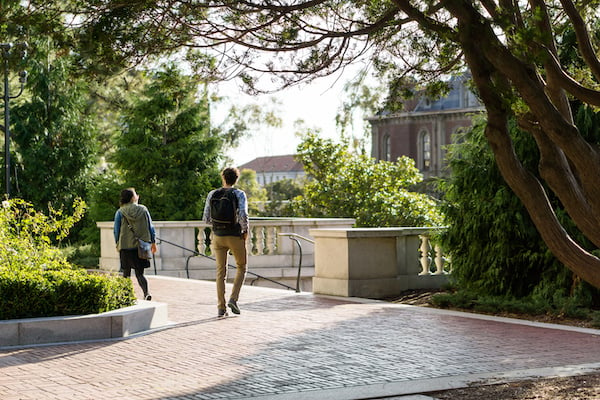Published on
Digital Innovations Within Higher Ed in the Wake of the Pandemic

In March 2020, as the COVID-19 pandemic struck, universities endured a massive teaching and learning crisis. To ensure academic continuity, they pivoted to emergency remote teaching and helped instructors and students make use of technologies unfamiliar to many. Now, in the wake of that crisis, higher education has the opportunity to identify and build on promising practices while mitigating the problems that emerged.
COVID-19 caused a loss of health and life on a catastrophic scale. At residential colleges, it also disrupted living and learning environments, interfering with young people’s expectations of the path to independence and adulthood and interrupting academic and early-career trajectories. Administrators, faculty, staff and students who scrambled to make remote learning work in the context of the pandemic were not just solving technical problems related to equipment, software or methodology; they were working to sustain trust on many planes—social, psychological and institutional.
At Stanford, our newly formed Stanford Digital Education team sought to understand and record the teaching and learning lessons learned during the pandemic. We hoped to synthesize the experiences of colleagues across our community before too much time had passed and memories had faded. Our goal was to consider what innovations might be carried forward as part of Stanford’s future digital education strategy. A year of gathering and closely reading materials produced during the pandemic, along with interviewing nearly 60 leaders, faculty, staff and students, underscores how instructors tapped into professional communities and support structures to innovate in support of the whole student’s needs.
The pivot to emergency remote teaching was a mass professional development experience for faculty and staff. It spurred a drive to share resources and knowledge, both within and among institutions. At Stanford, “community of practice” Slack channels multiplied; a revived Teaching Commons website, where instructors and staff could share effective practices, served as an information repository. For anyone designing or teaching a course for the first time, tapping into knowledge networks was a survival skill; contributing to them meant that you were helping write the guidebook.
The exigencies of teaching in a new modality led to experimentation in many courses. Instructors developed content in a variety of media, instructional video was recorded and integrated in levels never seen before, and flipped instructional designs proliferated. Assessment design shifted from high-stakes summative evaluations to more formative assessments or to project-based demonstrations of mastery.
Faculty sought student input on how well these approaches worked. Students had positive feedback for many practices but also valued the care with which instructors redesigned their courses. One student interviewed said, “When faculty tried to adapt their courses to the needs of students learning online, students felt more engaged.”
The connection between student well-being and student learning was not new, but it became more visible, and awareness of that connection shaped the university’s and instructors’ efforts to teach in remote classrooms. When students were forced to leave campus, the university recognized that basic technology needs had to be met: Learning technologies staff consulted with the financial aid office to ship laptops to students who needed them and solved connectivity issues for students across the globe.
The need for such measures became more apparent because the pandemic exposed—and exacerbated—existing inequities. The Stanford campus typically houses 97% of all undergraduates. The undergraduate residential experience has a leveling effect during normal academic operations: Students live together, eat together and share access to quiet study spaces and services. As the campus closed and students went home, some lacked private or quiet places to study. Some, particularly in rural areas, did not have the internet connectivity required to engage fully in course content. Others had caregiving obligations, while many faced burdens of increased anxiety, depression and isolation.
As faculty learned the technicalities of using Zoom, many tried to provide added support for students. They adjusted their class rhythms to include time to greet and check in with students and added structures that increased students’ interactions with each other—interactions that both aided learning and helped build community.
Student experiences during emergency remote learning were not monolithic. For some, courses became more inclusive. While it was common for students to struggle with motivation and focus, some benefited from improved access to course materials. In certain instances, students with disabilities felt able to participate on more even terrain. Volume control in Zoom could help bring forward quiet voices in discussions. Shy students who were reluctant to talk could enter a conversation by writing comments in a chat instead. Those who needed to hear explanations repeated could rewatch relevant parts of recorded lessons.
Many students were increasingly vocal about their needs for more flexibility while taking care of themselves. Similarly, some were empowered to take on a greater role in shaping their education. These students supported instruction and, in some courses, even worked to co-design syllabi and learning outcomes in partnership with instructors. Despite—or perhaps because of—social distancing mandates, the interdependence of the Stanford learning community was most palpable during the most physically isolating times of the early pandemic.
Now, as we resume face-to-face instruction nationwide, more students than ever are suffering from depression and anxiety. Stanford has not been spared: Accommodation requests, many for mental health reasons, are at an all-time high. The lessons we learned from the pandemic are as relevant as ever.
Flexibility continues to be crucial to supporting students. Instructors learned a great deal about building inclusive learning environments during the pandemic. When we expand flexibility and adapt instruction to accommodate diverse learners and their needs, learning can be designed to accommodate all learners by default. This effort could eventually mean special accommodations are not needed because learners’ needs are met by design.
To get there, higher education institutions should invest in the collaborative approaches that produced pandemic adaptations and innovations. We should invite all our colleagues to contribute to improvements in a spirit of openness and creativity.
Above all, it became clear during the pandemic that students need to feel supported as whole people to show up fully in their learning and in their research. No matter the course modality, empathy for students plays a major role in ensuring that students thrive and succeed.
Author Perspective: Administrator



